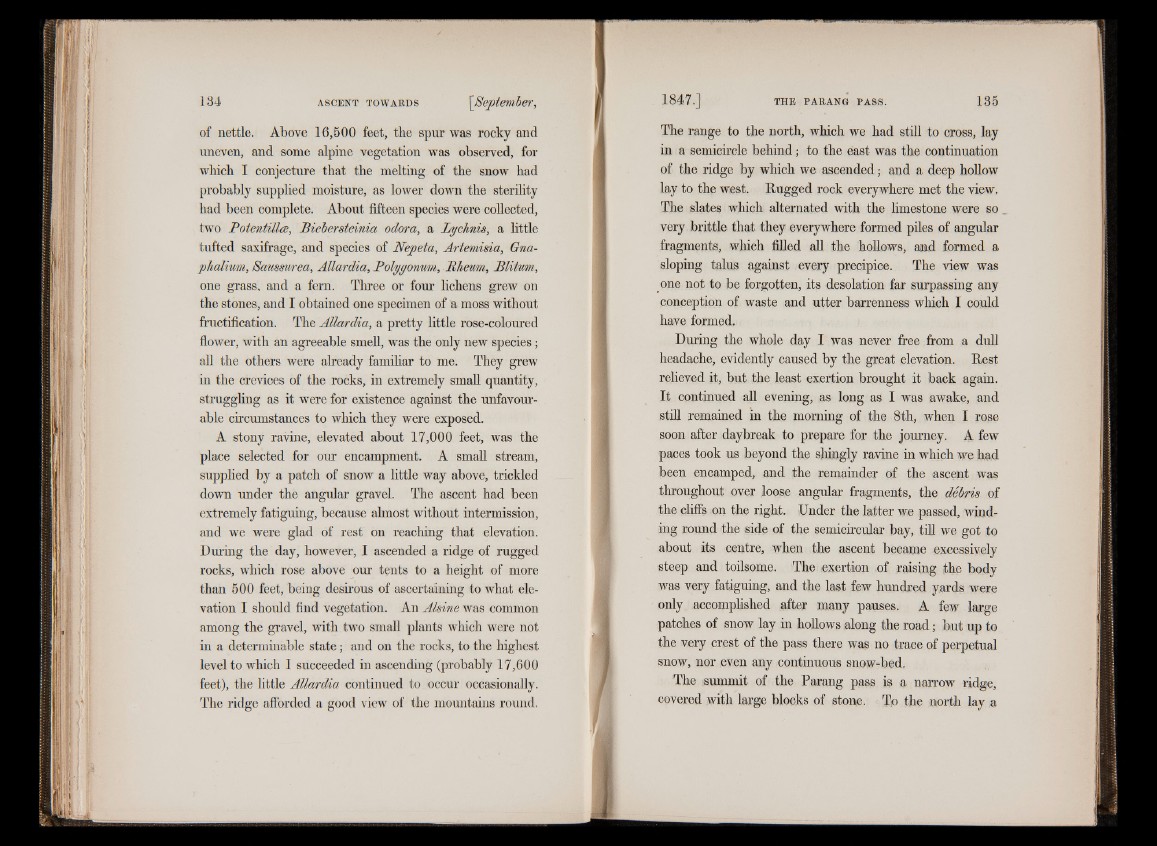
of nettle. Above 16,500 feet, the spur was rocky and
uneven, and some alpine vegetation was observed, for
which I conjecture that the melting of the snow had
probably supplied moisture, as lower down the sterility
had been complete. About fifteen species were collected,
two Potentillce, Biebersteinia odora, a Lychnis, a little
tufted saxifrage, and species of Nepeta, Artemisia, Gna-
phalium, Saussurea, Allardia, Polygonum, Rheum, Blitum,
one grass, and a fern. Three or four lichens grew on
the stones, and I obtained one specimen of a moss without
fructification. The Allardia, a pretty little rose-coloured
flower, with an agreeable smell, was the only new species;
all the others were already familiar to me. They grew
in the crevices of the rocks, in extremely small quantity,
struggling as it were for existence against the unfavourable
circumstances to which they were exposed.
A stony ravine, elevated about 17,000 feet, was the
place selected for our encampment. A small stream,
supplied by a patch of snow a little way above, trickled
down under the angular gravel. The ascent had been
extremely fatiguing, because almost without intermission,
and we were glad of rest on reaching that elevation.
During the day, however, I ascended a ridge of rugged
rocks, which rose above our tents to a height of more
than 500 feet, being desirous of ascertaining to what elevation
I should find vegetation. An Alsine was common
among the gravel, with two small plants which were not
in a determinable state; and on the rocks, to the highest
level to which I succeeded in ascending (probably 17,600
feet), the little Allardia continued to occur occasionally.
The ridge afforded a good view of the mountains round.
The range to the north, which we had still to cross, lay
in a semicircle behind; to the east was the continuation
of the ridge by which we ascended; and a deep hollow
lay to the west. Rugged rock everywhere met the view.
The slates which alternated with the limestone were so
very brittle that they everywhere formed piles of angular
fragments, which filled all the hollows, and formed a
sloping talus against every precipice. The view was
one not to be forgotten, its desolation far surpassing any
conception of waste and utter barrenness which I could
have formed.
During the whole day I was never free from a dull
headache, evidently caused by the great elevation. Rest
relieved it, but the least exertion brought it back again.
It continued all evening, as long as I was awake, and
still remained in the morning of the 8th, when I rose
soon after daybreak to prepare for the journey. A few
paces took us beyond the shingly ravine in which we had
been encamped, and the remainder of the ascent was
throughout over loose angular fragments, the debris of
the cliffs on the right. Under the latter we passed, winding
round the side of the semicircular bay, till we got to
about its centre, when the ascent became excessively
steep and toilsome. The exertion of raising the body
was very fatiguing, and the last few hundred yards were
only accomplished after many pauses. A few large
patches of snow lay in hollows along the road; but up to
the very crest of the pass there was no trace of perpetual
snow, nor even any continuous snow-bed.
The summit of the Parang pass is a narrow ridge,
covered with large blocks of stone. To the north lay a